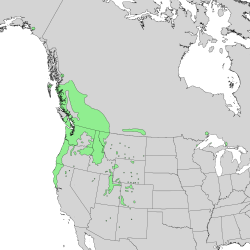| Crataegus douglasii | |
|---|---|
 | |
| Scientific classification | |
| Kingdom: | Plantae |
| Clade: | Tracheophytes |
| Clade: | Angiosperms |
| Clade: | Eudicots |
| Clade: | Rosids |
| Order: | Rosales |
| Family: | Rosaceae |
| Genus: | Crataegus |
| Species: | C. douglasii |
| Binomial name | |
| Crataegus douglasii | |
 | |
| Natural range of Crataegus douglasii | |
| Synonyms | |
C. brockwayae Sarg. [2] | |
Crataegus douglasii is a North American species of hawthorn known by the common names black hawthorn and Douglas' thornapple. It is most abundant in the Pacific Northwest.










